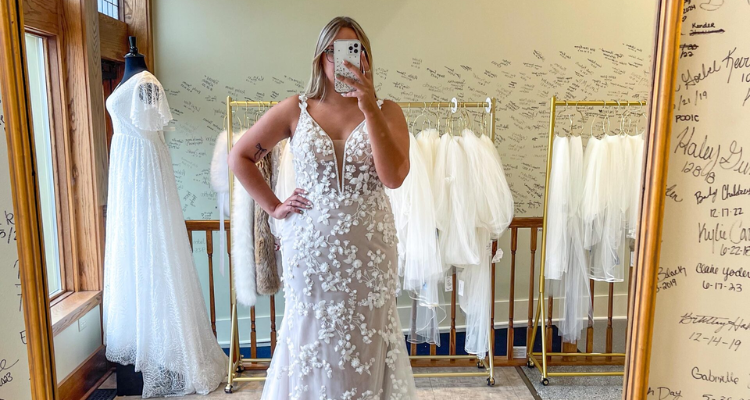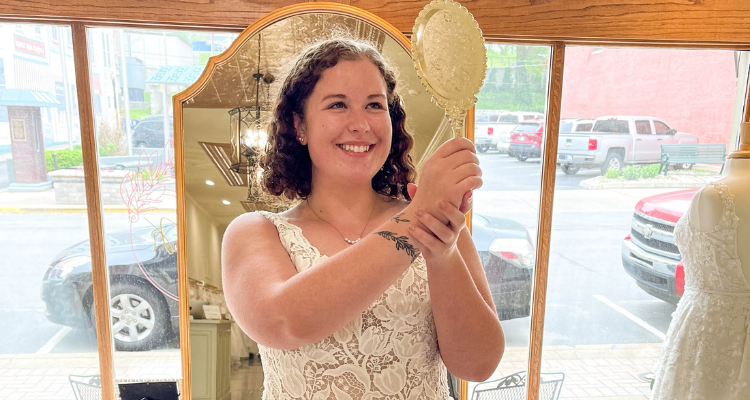
Navigating the world of bridal fashion can be a bit overwhelming—but it doesn’t have to be. With so many styles, silhouettes, and fabrics to explore, understanding the basics can make your dress-shopping experience more enjoyable and less stressful.
This guide is here to help you feel confident as you step into your first bridal appointment. From wedding dress silhouettes to the beautiful details that make each gown unique, we’ll break down some key terms you’ll likely encounter during your dress search.
Understanding these terms will not only help you communicate more clearly with your stylist, but it’ll also empower you to make more informed decisions when choosing the dress that feels just right for you.
So let’s get started—here’s what you’ll want to know before diving into the world of wedding dresses.
Wedding Terms: Bridal Fashion Basics
Before you start trying on dresses, it’s helpful to know a few key bridal fashion terms. These basics will give you a strong foundation and help you better understand the options available.
Some of the elements that define a wedding gown include:
- Silhouettes like A-line, ball gown, and mermaid
- Necklines such as sweetheart and V-neck
- Fabrics including lace, satin, and chiffon
- Trains that vary in length, from sweep to cathedral
Being familiar with these details will help you express what you’re looking for and make it easier for your bridal stylist to find dresses that match your vision.
Understanding Silhouettes
The silhouette refers to the shape and structure of the dress. It plays a big role in how a gown looks and feels.
-
A-line: Universally flattering with a fitted bodice and a skirt that flows out gently.
-
Ball gown: Perfect for a princess moment, this style has a full skirt and lots of drama.
-
Mermaid: Hugs your body from chest to knee, showing off curves with a bold, sexy vibe.
-
Sheath: Sleek and minimal, this style skims the body for a modern, understated look.
Knowing which silhouette appeals to you can narrow down your options and bring you closer to your dream dress.
Necklines and Sleeves
The neckline and sleeves shape a gown’s overall look—and how you feel wearing it.
-
Sweetheart neckline: Romantic and flattering, especially around the bust area.
-
V-neck: Classic and elongating, great for adding a touch of elegance.
-
Illusion neckline: Sheer fabric blends coverage with a hint of allure.
-
Cap sleeves & long sleeves: From delicate coverage to full elegance, sleeves add personality and practicality.
Try on a few variations to see what complements your shape and style best.
Fabrics and Textures
The fabric of your gown affects how it moves, photographs, and feels.
-
Satin: Smooth and glossy—great for a more formal look.
-
Lace: Timeless and romantic, with intricate patterns and vintage vibes.
-
Tulle: Light and floaty—perfect for creating volume without heaviness.
-
Chiffon: Airy and graceful, ideal for a relaxed or beachy setting.
Each fabric brings a different personality to a gown, so let your venue, season, and vibe guide you.
Trains and Lengths
Trains are the extended part of a gown that trails behind you—offering drama, elegance, or just a little extra flair.
-
Sweep train: Subtle and easy to manage.
-
Chapel train: Mid-length and classic for most ceremonies.
-
Cathedral train: Long and grand—perfect for traditional or formal weddings.
-
No train: Great for casual celebrations or easy movement.
Think about your venue, photo ops, and how much freedom you want on the dance floor when deciding.
Embellishments and Color
The details make the dress. Embellishments like beading, lace, and appliqués add sparkle, depth, and individuality.
-
Beading: Adds shine and elegance—can be subtle or bold.
-
Lace: Gives a soft, romantic touch.
-
Appliqués: Adds texture and eye-catching flair.
When it comes to color, today’s brides aren’t limited to white or ivory. You’ll see:
-
Blush, champagne, and pale gold for a soft twist on tradition.
-
Bold colors like burgundy for a modern, statement-making look.
Don’t be afraid to explore what speaks to your personal style.
Embellishments: Beading, Lace, and Appliqués
Embellishments can completely transform the look and feel of your wedding gown. Whether you’re going for something modern, classic, or whimsical, the right embellishments can reflect your personality and wedding theme beautifully.
- Beading adds sparkle and sophistication—it can be subtle or statement-making, depending on your style.
- Lace brings timeless elegance with its delicate patterns, perfect for romantic or vintage-inspired looks.
- Appliqués add texture and flair. They’re often used to draw attention to specific areas, like the bodice, sleeves, or hemline.
By paying attention to these details, you’ll have a better idea of what styles flatter you most and help you find a gown that truly feels like “you.”
The Role of Color in Bridal Fashion
Gone are the days when white was the only option—color is making waves in bridal fashion. Soft pastel shades like blush, champagne, and pale blue add a touch of charm and individuality. Meanwhile, bold tones like black or deep red are becoming popular choices for brides who want to make a striking statement.
Color plays a big role in setting the tone for your wedding. It can enhance the theme, reflect your personality, and even influence how your dress looks in photos.
Exploring different color options can help you discover a gown that feels both unique and true to your vision. Whether you lean traditional or love something more unexpected, the right hue can make all the difference.
Dress Codes Decoded (for Guests Too!)
Understanding dress codes helps you dress appropriately—not just for your own wedding, but for attending others too.
Here’s a quick breakdown:
-
Black-tie: Tuxedos and floor-length gowns.
-
Cocktail attire: Shorter dresses or dressy separates—think chic but not overly formal.
-
Business casual: Polished, comfortable options like slacks or modest dresses.
This knowledge can also help if you’re planning a dress code for your own wedding. Clarity makes it easier for guests to come dressed appropriately (and confidently!).
Conclusion:
Knowing the lingo will empower you to make more informed decisions and ensure that you’re able to communicate your preferences clearly. Understanding the different bridal styles, trends, and cultural attire will help you navigate your options with confidence, and make the shopping experience feel more enjoyable.
Whether you’re looking for the latest trends or something that honors your heritage, being prepared with the right knowledge ensures that you find a gown that truly reflects your style. By familiarizing yourself with these important terms, you’ll be ready to step into your dress shopping experience feeling confident, informed, and excited to find the perfect dress for your special day.

